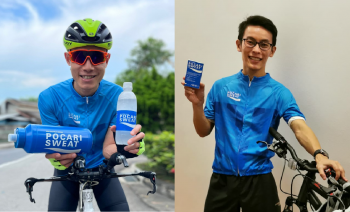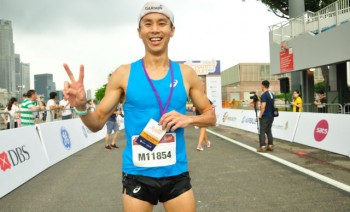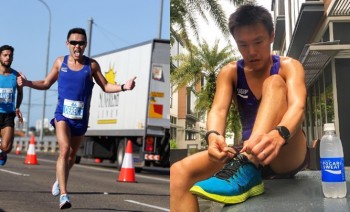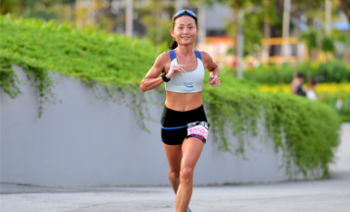
In Conversation with Dr. Lim Baoying On Hydration
Updated: 15 May 2017 | Written By: Pocari Sweat
We interview Dr Lim Baoying, a Resident Physician at Changi Sports Medicine Centre to share some insights on proper hydration.
Many of us know that staying hydrated is an essential component of our everyday lives. However, a common misconception is that we are only dehydrated after strenuous activity. With the recent heat wave in Singapore, it is even more imperative that we understand the importance of proper hydration.
We invite Dr Lim Baoying (LBY) to shed some light on the topic, as well as share some tips on how to check our own hydration status. As an avid endurance athlete herself who has completed 14 marathons, Dr Lim will also share how proper hydration can impact our sports performance and physical activity.
AA: How does dehydration come about? What are some problems we may face if we do not hydrate ourselves properly?
LBY: Dehydration arises when we lose more fluid from our bodies than what was absorbed. We lose fluid from perspiration, waste elimination, and other metabolic processes in the body. Exercising in hot temperatures (resulting in profuse sweating); diarrhea; increased urination due to medication use (diuretics); and increased metabolic rate such as running a fever, are examples of how dehydration could occur when we do not hydrate enough to catch up with the fluid loss.
When we are dehydrated, we are unable to regulate our core temperature. Our heart rate would increase and the effort of perceived exertion during exercise would increase as well. As the dehydration continues, we would have reduced athletic and mental performance, poor coordination, and suffer heat injuries such as muscle cramps, heat exhaustion and even a heat stroke.
AA: What are some common misconceptions many of us may have when it comes to hydration?
LBY: Hydration is important to everyone, whether you exercise or not. Thirst is not a good indicator of dehydration. The sensation of thirst goes off when we drink before the level of dehydration is adequately corrected.
There are other ways of checking out your hydration status:
Weight
Take your weight in the morning after urination without your clothes on and compare it to post-exercise weight (without clothes as well). The weight loss is likely attributed to the amount of fluid loss; i.e. 1kg loss= 1L of fluid lost.
|
Level of hydration |
Body Weight Change (%) |
|
Well Hydrated |
-1 to +1 |
|
Minimal Dehydration |
-1 to -3 |
|
Significant Dehydration |
-3 to -5 |
|
Serious Dehydration |
> -5 |
Correct the amount of dehydration over two hours post-exercise with approximately 1.5L of fluid per kilogram of body weight lost.
Urine colour
The darker the urine colour, the higher the level of dehydration. If you are able to pass a large amount of pale-coloured urine on regular basis, you are probably well-hydrated.
AA: Besides loading up on water and fluids, are there other ways we can stay hydrated?
LBY: The foods we consume also contributes to the fluid amount we ingest. In fact, up to 20 percent of our fluid intake comes from food intake. Choosing certain foods over other food types can help increase the amount of water we consume. These include fruits high in water content such as watermelons and papayas; or vegetables such as cucumbers, tomatoes, lettuce and celery; or soupy dishes such as porridge or fish soup.
Do take note of the fats, sugar and salt levels of the fruits and soup or sauce in these foods consumed. The sodium content in the food we consume also helps with the retention of fluid in our bodies.
Minimizing water loss is also another way to keep yourself hydrated. Keeping your environment cool and dry (i.e. air conditioning); wearing clothes that are made of a breathable and light material, or choosing a cooler time of the day to exercise, are some measures you can take to ensure you do not lose more fluid than your consumption.
AA: As a marathoner yourself, how does hydration affect the body during exercise or strenuous activity?
LBY: As mentioned earlier, staying hydrated is required in body processes such as thermal regulation, blood pressure maintenance, nutrition delivery and waste processing. If dehydration is above two percent of your body weight fluid loss, these processes may not take place optimally. Reduced exercise capacity, fatigue, muscle cramps, giddiness and even fainting might occur in a dehydrated athlete. Exertional heat injury, or even a heat stroke might set in at greater levels of dehydration with adverse outcomes.
AA: What are some benefits we may experience from consuming drinks that have a similar composition to our body fluid, for instance, Pocari Sweat?
LBY: Not all drinks are created the same for the purpose of hydration. Electrolytes, carbohydrates, and even other macro-nutrients such as proteins and fats would differ from drink to drink. Beverages such as Pocari Sweat have a composition closest to our body water, and allow for faster absorption and replacement of body water lost during dehydration.
AA: Given the recent heat wave in Singapore, losing more fluids through perspiration is an increasingly common affair. What are some hydration tips you would recommend to help us get through these warmer conditions?
Chill your drinks so that they can help cool your bodies besides hydrating you.
Drink frequently, or even set time intervals so that you are constantly hydrated – even when indoors or not exercising. Of course, greater amounts of fluids have to be consumed when exercising. Be sure to start off your exercises in a hydrated state – consume around 5-7 mL per kg body weight of fluids at least 4 hours prior to your exercise session.
Drink to replace – follow this principle of hydration during exercise. Of course, this would depend on your sweat rate, which is dependent on your body size, level of training, exercise environment etc. But a rough guide would be around 2 mL per kg body weight of fluid every 15 minutes.
When you exercise for more than an hour, opt for an isotonic drink for hydration purpose as the carbohydrate and electrolyte content will help maintain sports performance and replace sweat and electrolyte losses simultaneously. Then replace the level of dehydration over two hours post-exercise with approximately 1.5L of fluid per kilogram of body weight lost, as mentioned above.
AA: Thank you for sharing, Dr Lim.
LBY: You’re welcome.
Interview Credits: http://activeage.co/in-conversation-with-dr-lim-baoying-on-hydration/
Photo Credits: Pictureart Gallery





